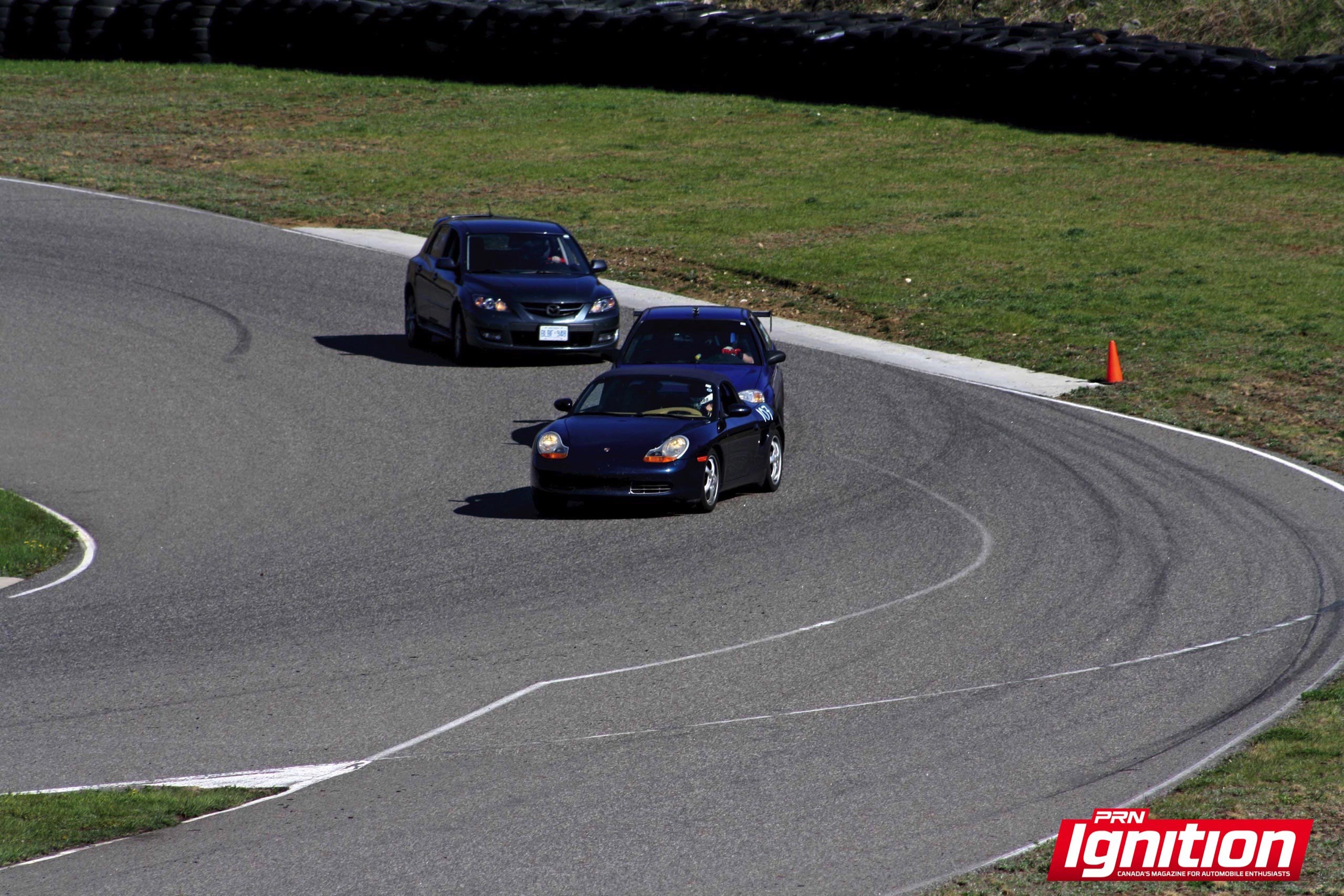
Whether you are a novice venturing out for your first track day or a seasoned racer, there is always something to learn and several key concepts to keep in mind each time we go to the track. In keeping with the theme of this column “The Next Step,” I’m gearing this piece towards a beginner driver – but I encourage all drivers, even highly experienced ones to have a read here – there are several core concepts and a few details that will be beneficial and applicable to advanced drivers as well.
Set Your Goals and Expectations
 Step one is to fully understand the environment and be properly prepared. Going to a driver education or lapping event is not racing, but all of the inherent risks are still there. We are still going fast and accidents can happen. In most cases you will be in a street car, which is VERY different from a race car. While a street car often has as much or more horsepower than a fully built race car, it does not have any of the safety features of said race car. I’m talking roll cages, fire suppression systems, window nets and six-point harnesses, etc. So right off the bat, understand that if you have a crash you are more likely to be injured in your street car than a race car. Let this temper your enthusiasm and ego appropriately. Try to set your goals on healthy things like learning the racing line or perfecting a certain corner. Avoid getting wrapped up with lap times or beating “that guy” in the _____________ (insert exotic car of your choice here).
Step one is to fully understand the environment and be properly prepared. Going to a driver education or lapping event is not racing, but all of the inherent risks are still there. We are still going fast and accidents can happen. In most cases you will be in a street car, which is VERY different from a race car. While a street car often has as much or more horsepower than a fully built race car, it does not have any of the safety features of said race car. I’m talking roll cages, fire suppression systems, window nets and six-point harnesses, etc. So right off the bat, understand that if you have a crash you are more likely to be injured in your street car than a race car. Let this temper your enthusiasm and ego appropriately. Try to set your goals on healthy things like learning the racing line or perfecting a certain corner. Avoid getting wrapped up with lap times or beating “that guy” in the _____________ (insert exotic car of your choice here).
Set Healthy Priorities
Safety Equipment
First and foremost, focus on the essential safety equipment. A good helmet, six-point harnesses and a HANS device should be the starting point. A racing seat with full side and hip bolstering is a smart idea as is a proper racing suit, gloves and shoes. A full roll cage will make the car illegal for road use (therefore necessitating a trailer and tow vehicle) but it really is an important step fairly early in your development, as is a fire suppression system and window nets. A half-cage is a decent starting compromise and helps with the six-point belts as well.
Seek Professional Instruction
For men, our egos often struggle with this one, because we are naturally born as the world’s greatest lovers and drivers right? Hiring someone to teach you how to drive is sacrilege! Well, we also used to think the world was flat, so let’s get with the times and understand that track driving has nothing in common with street driving and that it requires some education. Learning things from a legitimate pro (someone who makes their living in the driving world) will: a) get you up to speed faster, b) make you safer, and c) help you avoid MANY of the bad habits all too common from doing it by yourself or working with a lower tier instructor. The power of habits is damn near infinite. I’d say 75% of everything I do in my professional coaching career is getting people to unlearn bad habits that they picked up by saving money or thinking they didn’t need any guidance in their early days. It is much easier (and cheaper in the long run) to learn something the right way the first time.
Better Brakes
Street car brakes are not designed for the load and heat that track driving produces. It’s incredibly easy to kill a set of pads, boil your brake fluid and warp your rotors in less than a day of track driving (less than 20 minutes in many cases). Not only will this get expensive really fast, it’s also dangerous. Once your brake fluid boils your peddle gets long and your ability to stop reduces dramatically. Take it from me – feeling your brake pedal go to the floor while nothing happens is one of the scariest things you could ever experience on a race track!
 Suspension and handling
Suspension and handling
Cornering fast is fun. Improving your suspension also improves your safety due to the increased control and stability. Look into upgrading your bearings and bushings as well; as with stock brakes, most cars are not designed for the loads a race track will generate. Not having to replace bearings and bushings all the time will save you money long term.
Horsepower
Notice I listed this last? Until you (and your brakes and suspension) are ready for it, adding horsepower will just make you more dangerous. The quickest way to lower your lap times is through learning to drive properly through your braking and cornering – hence professional instruction. We (the professionals racers) make fun of the guy who shows up with his juiced-up-jumbo turbo-chipped-custom-exhaust-super-motored car. Especially when we lean in and see stock seats, a three-point harness and a $100 motorcycle helmet.
At the Track
Seating Position
Seating position is rarely considered but makes a massive difference to your driving. Most of us sit too far away from the steering wheel. You must be close enough to the wheel that, with your back pressed into the seat, you can get a full lock of steering on and still have a bend in your arm. The angle of the back of the seat is important as well. You don’t want to be too upright or it will put your natural vision resting position too low. We need to have our natural line of vision up and looking at the horizon. Pay great attention to this detail. This means the seat should be reclined a little.
Vision
Vision is hands down, the number one most important element to driving on a track – or anywhere for that matter. Ninety per cent of proper driving instruction is all about where you look. Here is the science behind it: out of the approximately 180 degrees of vision we have, there is a narrow band called the Central Focal, or Foveal Vision – it’s about three degrees of your 180. What this sees directs all of your body movement. It is how you catch a ball, ski through the trees, pick up a pen, and walk through a doorway. It is your body’s hardwired visual targeting system. Therefore – where you directly look, is the be all, end all.
 Step one is understand this. Step two is learning to move your eyes and use this to your advantage. The biggest issue track drivers have is not being used to the rate of approach. Simply put, you are going much faster than you do on public roads and the scenery (or more importantly the next corner) is approaching faster than your eyes and brain are used to dealing with. Learning to look farther ahead, and move your eyes to the correct target (i.e. braking point, start of the corner, apex, corner exit) at the correct time is where the skill and art is found. We need to give our eyes and brains time to get up to speed. The most effective advice I give to my clients is to start off slow, drive the first few laps really slow (less than 50% or below 125 km/h slow), get your eyes accustomed to looking farther ahead and get your head and neck accustomed to looking around, side to side, up and down. While going this slow, focus on nothing but seeing the track. Look for the important bits – track bends, braking markers, apex curbs, exit curbs, etc. These details will increase as your visual powers grow.
Step one is understand this. Step two is learning to move your eyes and use this to your advantage. The biggest issue track drivers have is not being used to the rate of approach. Simply put, you are going much faster than you do on public roads and the scenery (or more importantly the next corner) is approaching faster than your eyes and brain are used to dealing with. Learning to look farther ahead, and move your eyes to the correct target (i.e. braking point, start of the corner, apex, corner exit) at the correct time is where the skill and art is found. We need to give our eyes and brains time to get up to speed. The most effective advice I give to my clients is to start off slow, drive the first few laps really slow (less than 50% or below 125 km/h slow), get your eyes accustomed to looking farther ahead and get your head and neck accustomed to looking around, side to side, up and down. While going this slow, focus on nothing but seeing the track. Look for the important bits – track bends, braking markers, apex curbs, exit curbs, etc. These details will increase as your visual powers grow.
Using the Brake Pedal
The other relevant starting point is how we use the brake pedal. And this is not a beginner thing – it’s common with most advanced drivers and club racers. We need to hit the brake pedal with much more force than we are used to. And we need to modulate that force in the exact opposite way as well! It’s a whole new muscle memory to learn. Our street driving habits are to gently increase brake pressure. On the track we want to quickly develop max brake pressure, then gradually release that pressure as we get closer to steering into the corner. Hit it hard, activate and feel the ABS – hard! Then bleed off pressure. By gently releasing the brake pressure as we near the corner we are gently balancing the weight of the car and giving the front tires more grip to steer with. It also has a side benefit of making the corner entry seem less ragged and on edge. It calms the nerves and allows you to be more precise. Exploring how hard you can brake helps you discover your car’s true stopping potential and allows you to stay on the gas pedal longer. Do some experimenting with this and test it out. Mastering brake release in conjunction with steering input is what separates the good from the great.
Eyes up, hands relaxed and enjoy the ride.
Yours in driving, Aaron






















